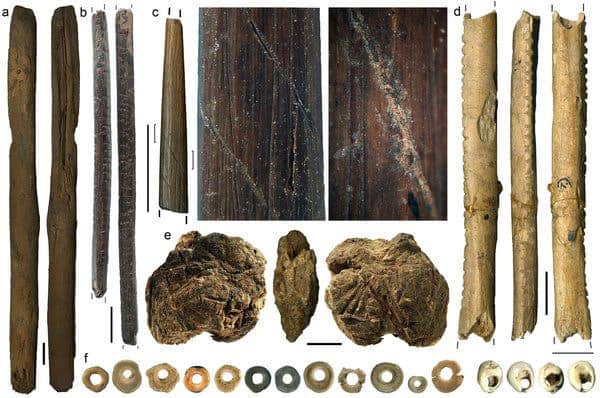
New, more precise carbon dating of artifacts found in South Africa, such as poison-tipped arrows or ostrich eggs, have been found to be 44,000-year-old. The technology and social behavior at play suggest that modern human culture in the area may have emerged some 20,000 years earlier than previously thought and supports the theory that all modern human culture descended from South Africa.
The artifacts were first discovered at Border Cave, called so because it’s situated at South Africa’s northeastern border with Swaziland. There paleontologists found whole bodies and fragments of, what can only be described as, hunting kits – thin bone arrowhead points, wooden digging sticks, a gummy substance called pitch that was used to haft, or attach, bone and stone blades to shafts and a lump of beeswax likely used for hafting. Also, ostrich eggs were found. The researchers speculate that the eggs were not only used for decurative purposes, but also played a major role in bartering with neighboring groups, hinting towards an evolved social dynamic in the area.

An international team of scientists, lead by the University of Colorado Boulder, used precisely calibrated radiocarbon dating for the organic artifacts found at Border Cave in the Lebombo Mountains, an area where evidence was found of hominid occupation going back 200,000 years. In fact, to this day, the area is occupied by San people – an indigenous group which still practices hunter-gatherer culture and whose genetic ancestry is one of the oldest in the world. The researchers findings prove that the Later Stone Age in South Africa likely began some 44,000 to 42,000 years ago, according to Paola Villa, a curator at the University of Colorado Museum of Natural History and lead study author.
“Our research proves that the Later Stone Age emerged in South Africa far earlier than has been believed and occurred at about the same time as the arrival of modern humans in Europe,” said Villa. “But differences in technology and culture between the two areas are very strong, showing the people of the two regions chose very different paths to the evolution of technology and society.”
The paper has a number of shaping conclusions. For one, the populace at the time seems to have gone through a technological transition, going from spears hafted with stone points — the main hunting weapon in the Middle Stone Age — to the likely use of the bow and arrow, a technology that included very thin bone points that probably were tipped with poison.
“The very thin bone points from the Later Stone Age at Border Cave are good evidence for bow and arrow use,” said Villa. “The work by d’Errico and colleagues shows that the points are very similar in width and thickness to the bone points produced by San culture that occupied the region in prehistoric times, whose people were known to use bows and arrows with poison-tipped bone points as a way to bring down medium and large-sized herbivores.”
The poison in use 40,000 years ago was ricinoleic acid, according to chemical analysis – derived from the seeds of castor oil plants and which has been identified as being used in South Africa at least 24,000 years ago. “Such bone points could have penetrated thick hides, but the lack of ‘knock-down’ power means the use of poison probably was a requirement for successful kills,” said Villa.
The discovery also represents the first time pitch-making has been documented in South Africa, Villa said. The process requires burning peeled bark in the absence of air. The Stone Age residents probably dug holes in the ground, inserted the bark, lit it on fire, and covered the holes with stones, she said.
All modern human behavior originated from South Africa?
The paper suggests that the fossils are an indications which serves to substantiate the claim that all modern culture came from south Africa, despite the fact the researchers themselves acknowledge that it remains difficult to pinpoint where in history that modernity began. The idea was first proposed by Stanford University archaeologist Richard Klein, who claimed that fundamental human behavior had its beginnings 50,000-60,000 years ago in Africa and spread to Europe. Like mentioned earlier in the article, this time frame would correspond with the presence of European modern human settlements, as well as the extinction of native European Neanderthals who were pressured by the new hominid species – the dominant modern humans.
Other scientists aren’t convinced, though.
“They say, ‘Modern human behavior first found!’” said Eric Delson, a paleoanthropologist at Lehman College of the City University of New York. “Well, not exactly.” Delson, who was not involved in the study, mentions that the reseachers’ efforts are indeed valuable, however there isn’t a clear and definite link between these recent findings and the claim that all modern culture comes from Africa.
The findings were reported in the journal Proceedings of the National Academy of Sciences.






